Callistemon viminalis



Furrowed
Having thick bark forming furrows .
Medium dome
A large shrub or tree with spreading branches with a medium rounded outline.This small tree has an elegant and weeping habit with many slender branches that form an open crown. It has dark green lanced-shaped leaves that are pinkish when young and red bottlebrush-like flowers appear during spring.
Callistemon viminalis (Gaertn.) G.Don, naturally found from northern New South Wales to Cape York in northern Queensland, Australia. It grows on the coastal plains along watercourses and on hillsides in the tablelands, extending to the western slopes and appearing from sea level to an elevation of 900 m (2,952 ft). It prefers a most, well drained to boggy moderately fertile sandy-stony to light clay soil that is acidic to neutral with a pH range from 5.5 to 7.5. It grows in a sunny open position and is drought or temporary inundation tolerant but frost tender with a preferred minimum winter temperature of 7.2ºC (45ºF).
The Weeping Bottlebrush is grown for its attractive pendant red flowers and small tree-like habit. It is used as a street tree tolerating neglect or is planted along borders for screening and as a windbreak. It is also used for erosion control along embankments or for absorbing water in damp areas. This adaptable plant is 2nd line salt tolerate and is highly bird attracting when in flower. It has a medium growth rate establishing in 2 to 3 years and matures in 10 to 15 years. Once established it has a medium water requirement, (Scale: 2-drops from 3) preferring organic rich deep soil that is reliably moist and tolerates periodic inundation.
I.D. 148
UK hardiness zone H2
Climate zones 6, 9, 12 - 24
USDA Zone 9-12
Callistemon (ka-LEE-stay-mon) viminalis (vim-i-nal'is)
Etymology
Genus: - Greek - Callistemon – from ‘kallistos’ - meaning (most beautiful) and ‘stemon’ meaning (a stamen) referring to the flowers
Species: Latin – viminalis – meaning (with long flexible stems) alluding to the its pendulous growth habit
Common names; Red Bottlebrush, Weeping Bottlebrush, Drooping Bottlebrush
Cultivars
'Captain Cook'
This shrub grows to 2 m (6 ft) tall by 1.5 m (5 ft) wide with a woody trunk and a semi weeping habit branches that form a rounded crown with light green lanced-shaped leaves. The crimson flowers appear in cylindrical bottlebrush-like heads during spring after which it tolerates a light prune to thicken up. It is used as a lawn specimen or as an informal hedge, container plant and planted in borders for screening. It prefers a full sun position but tolerates some shade with wind protection in coastal regions and tolerates most well drained sandy to light clay loams, responding to mulch. Once established it has a medium water requirement, (Scale: 2-drops from 3) and responds to mulching with an occasional deep watering during dry periods.
'Dawson's River'
This shrub to small tree grows to 6 m (20 ft) tall by 5 m (15 ft) wide with an upright trunk with spreading branches that are covered in pendant grey-green lanced-shaped leaves. The bright red flowers appear in cylindrical bottlebrush-like heads during late spring after which it tolerates a light prune to thicken up. It prefers a full sun to semi-shade tolerating coastal regions and grows most well drained, moderately fertile to poor sandy to light clay loams, responding to mulch. It is used as a lawn specimen or planted in borders for screening and is bird attracting. It is drought tolerant and has a low water requirement once established.
'Hannah Ray'
This large shrub to small tree grows to 5 m (15 ft) tall by 2 m (6 ft) wide and is upright with a strongly weeping habit. The dark green lanced-shaped leaves that is pinkish when young and the large crimson bottlebrush-like flower heads appear from spring to summer. It is used as a lawn specimen and planted in borders for screening and is highly bird attracting. It prefers a full sun to semi-shade, tolerating coastal regions with some wind protection and grows most well drained, moderately fertile to poor sandy to light clay loams, responding to mulch. It is drought tolerant and has a low water requirement once established. When pruning, train to a single leader to form a tree habit or trim when young to form a shrub.
'King's Park Special'
This small tree grows to 5 m (15 ft) tall by 3 m (10 ft) wide and is upright with a slightly pendulous habit. From spring to summer masses of bright red bottlebrush-like flower heads appear and are highly bird attracting. It prefers a full sun to semi-shade, tolerating coastal regions with some wind protection and grows most, moist well drained, moderately fertile soils, responding to mulch. It is used as a lawn specimen or as an informal hedge, container plant and planted in borders for screening. It is moderately drought tolerant and has a low water requirement once established.
'Little John'
This dwarf shrub grows to 1 m (3 ft) tall by 1 m (3 ft) wide forming a compact rounded habit that has bluish-green lanced-shaped leaves. The dark red bottlebrush flower heads cover the plant during spring and are bird attractive. It prefers a full sun to semi-shade with some wind protection and grows most well drained, moderately fertile soils, responding to mulch. It is used in border planting or low hedge, responding to a light trim after flowering and as a container plant for patios and verandas. It is moderately drought and frost tolerant and has a low water requirement once established.
'Pendula'
This small shrub to 2 m (6 ft) is upright with slender pendulous branches and produces bright red flowers that are up to 75 mm (3 in) long. Commonly grown in small gardens as a specimen plant. It is frost tender and slightly drought tolerant and has a medium water requirement once established.

'Prolific'
This shrub to small tree grows to 6 m (20 ft) tall by 2 m (6 ft) wide with and upright trunk and slightly pendulous branches that are covered in bright green lanced-shaped leaves that are rich pink when young. The short dark red bottlebrush flower heads appear during spring and may reappear in autumn and are bird attracting. It prefers a warm temperate to tropical climate growing in full sun to semi-shaded position on dry or wet, well drained sandy soils. It is used as a lawn specimen or planted in borders for screening and used for street planting. It is moderately drought tolerant and frost tender and has a low water requirement once established.

Australia, (northern New South Wales to northern Queensland)
Myrtaceae (mir-TAY-see-ee)
Myrtle, Eucalyptus, Clove and Guava Family
This is a large family of shrubs, mallee and trees with showy stamens and peeling bark. It has a large representation in the Australian landscape.
Distribution
The plants in this family are predominantly found in the southern Hemisphere with 75 genera native to Australia and the remaining distributed in South America, Africa and the neighbouring islands. They are located in tropical rainforests, sclerophyll, heaths and woodlands in rich to poor dry soils.
Diagnostic Features
The simple leaves are normally opposite; occasionally spirally arranged with no stipules and normally an entire margin. There are pellucid oil glands dotted on the leaf, which may be obscured and when the leaf is crushed it is aromatic.
The juvenile, intermediate and adult leaves may be different in arrangement and shape on the same plant.
The regular flowers are hermaphrodite or sometimes unisexual and may be axillary, solitary, or arranged in cymes, umbles, terminal spikes, racemes or panicles. The floral tube covers the ovary and may continue above the ovary summit and form a disk around the ovary.
There are 4 to 5 sepals and petals normally fused to form a calyptra or are free.
The stamens are five to many and may be free or fused into 5-bundles that are opposite the petals.
They have an inferior to semi-inferior ovary that has 1 to 10 carpels, normally five with 1 to many ovules that are inserted on an axil that is basal or rarely a parietal placenta.
The style ends with a narrow stigma and the anthers normally open with longitudinal slits or pores.
The fruit may be a capsule, berry, nut or drupe-like with the cup that surrounds the ovary that is fleshy or dry and woody.
The seed may vary in structure and the cotyledons may be small or large.
Note:
This family has many attractive species and are extensively used in ornamental. Eucalyptus, Melaleuca, Callistemon and Thryptomrnes are just some of the plants represented and they are normally pollinated by insects, birds and in some cases by mammals.
This plant tolerates between USDA zones 9a to 12a and grows to 10 m (30 ft)
Fahrenheit 20º to 55º F
These temperatures represent the lowest average.
Celsius -3.9º to 12.7º C

Attention
This plant was last revised on the 8/04/2022
The information displayed on this plant is based on research conducted in our horticultural library and from reliable online resources. We also make observations of the plant that we photograph, and all care is taken to ensure the details are correct.
All photographs and data are covered by copyright. Apart from any fair dealing for the purpose of private study, research, reference or review, as permitted under the Copyright Act, no part including images and text may be reproduced by any means without written permission. The information presented on the map is only indicative and may contain errors and omissions. All inquiries should be addressed to sales@plantfile.com attention Peter Kirkland.

Simple
The leaf that is not divided.
Lanceolate
Broadest at the centre, three or more times long as broad (Lance-shape).
Alternate
Leaves are arranged alternately along the stem.
Entire
A leaf margin with no irregularities (smooth).
Cyathiform
A cup like shape.
Spike
It is an unbranched inflorescence with sessile flowers (a simple raceme).| Jan | Feb | Mar | Apr | May | Jun |
| Jul | Aug | Sep | Oct | Nov | Dec |
The cyathiform flowers have a short calyx tube with 5 -small decidious calyx lobes and 5 rounded petals. The numerious red stamens are arranged in a whorl and the flowers appear in a cylindrical spike up to 130 mm (5 1/8 in) long. The main flowering period is in early spring but spot flowering may occur throughout the year. The stamens are shed together as they are joined at the base and the flowers appear along or near the end of the branches.

Capsule
A dried dehiscent fruit, with an enclosing membrane normally containing may seeds."The Weeping Bottlebrush is grown for its attractive pendant red flowers and small tree-like habit. It is used as a street tree tolerating neglect or is planted along borders for screening and as a windbreak. It is also used for erosion control along embankments or for absorbing water in damp areas. This adaptable plant is 2nd line salt tolerate and is highly bird attracting when in flower. It has a medium growth rate establishing in 2 to 3 years and matures in 10 to 15 years.
Note:
Care should be taken when planting, as it has a vigorous root system, which can block drains.
There are many cultivars available.
This plant is susceptible to Painted Apple Moth, Nectar Scarabs, Plague Thrips, Callistemon Tip Borer, Sawfly, Gall Flies and Case Moths but is resistant to Phytophthora cinnamomi.
General pruning information
To maintain a bushy habit cut back just behind the spent flowers to a node. Be careful not to prune too hard into old wood as this may cause dieback. If an old plant becomes leggy it may be cut back to ground level, where it will rejuvenate.
Surface sow fresh seed thinly during spring and prick out when large enough to handle.
Take soft tip cuttings during summer of non-flowering shoots.
Propagation by Seed (General)
Germination
In order for a seed to germinate it must fulfil three conditions.
1. The embryo must be alive (a viable seed).
2. The seed must have no dormancy-inducing physiological, physical or chemical barrier to germination; also the seed must be nondormant.
3. The seed must have the appropriate environmental requirements, water, temperature and oxygen.
The interaction between these requirements and dormancy is complex and may lead to different environmental requirements that avoid the dormancy of a seed.
Sowing Seeds in Containers
There are two general methods for germinating seeds.
1. Sowing seeds in a flat or germinating bed, through which seedlings are pricked-out then, transplanted into another flat with wider spacing or directly to an individual pot.
2. Sowing seeds by placing them in to flats with the appropriate spacing or into individual pots.
This method is normally carried out with medium to large seeds such as woody plants and plants that are difficult to transplant.
Seedling production normally occurs in a greenhouse / glasshouse, cold frames and on hot beds.
Method of Seed Sowing
Fine seed is sown in pots or flats that are no deeper than 70 to 80 mm. using a sterilised well-drained media (soil). Fill the container to 20 mm from the top and sprinkle sieved peat to 3 mm depth.
Press the media down level and firm with a piece of timber and then thoroughly moisten.
Mix the fine seed with washed sand and then sow thinly on the surface. These may be lightly covered with sand.
Larger seeds may be covered with media or a hole is dibbled and the seed is placed in the media.
Watering Methods
For watering you may either mist the containers from above or place the container in tepid water and allow the water to raise through the pot to the surface of the media, then drain away and do not fill to the top of the container.
Place a piece of glass over the pot and store in a protected warm environment (glasshouse).
Seeds germinate best in darkness so shade the containers if in direct sunlight.
After the seedlings have sprouted remove the glass and ease the seedlings into direct light.
When the seedlings are large enough prick them out and transplant into larger containers and place them in a shade house to harden off.
Many seeds have different methods of seed preparation for germination such as nicking or cutting the seed coat to allow water penetration, also placing seeds in hot water and allowing it to cool off.
This is particularly important as it is softening the seed coat.
Asexual Propagation (Cuttings general)
Propagation from cuttings is possible because every cell of a plant containers the genetic information to create an entire plant.
1. Reproduction occurs through the formation of adventitious roots and shoots.
2. The uniting of vegetative parts with budding and grafting.
3. Taking stem cuttings and layering is possible due to the development of adventitious roots
4. Root cuttings can form new shoots and it is possible to join roots and shoots to form a new plant.
5. A new plant may be formed from a single cell in an aseptic culture system, (cloning).
It is important to propagate vegetatively as this form of cloning retains the unique characteristics of the cultivars or where particular aspects of a plant may be lost if propagated by seed.
Equipment Required for Taking Cuttings
1. A sharp knife that is not too large or a razor mounted in a handle.
2. Good pair of sharp secateurs that is clean.
3. A dibbler to make a hole in the media and allow the cutting to be placed in.
4. Propagation structures that are either a timber frame with glass or polyethylene cover or a glasshouse.
The object of the structure is to create an environment where the temperature and humidity can be controlled. This can be achieved with a simple cover over a pot with a wire frame and plastic.
This stops the draughts and maintains humidity.
5. A hotbed is a useful item as many plants root more quickly if the media is slightly warmer.
Bottom heat is obtained from thermostatically controlled heating cables that are running under the media.
6. Misting systems are of great benefit to cuttings as the regulated fogging with water inhibits the cuttings from drying out and as a result the cuttings may be grown in full sun.
This results in faster root development and less subject to diseases by fungi and bacteria.
7. Rooting mediums
The rooting medium must be well drained, sand may be used as long as it is thoroughly washed and leached of all salts. It is very well drained and it is excellent for cutting that root up quickly. Equal parts of sand and peat moss have good results for cuttings, which are left for a period of time to allow the roots to form.
Vermiculite and perlite are also used as a well-drained rooting media but has the same disadvantage as sand having no nutrients. The cuttings must be potted up as soon as the roots developed, or a light application of liquid fertiliser can be applied.
Types of Cuttings
Stem cuttings
These are the main types of cuttings.
1. Softwood cuttings
These cuttings are taken from young growth on side shoots and tip growth.
2. Semi hardwood cuttings
These cuttings are taken from wood that is firmer and semi ripe usually during mid summer.
3. Hardwood cuttings
These cuttings are taken from mature wood normally towards the end of the season.
4. Root cuttings
Cut sections of roots to obtain new plants during late winter to early spring.
5. Leaf cuttings
Cut the leaf blade in order to obtain new plants during the growing period of the plant.
Cutting preparation
Hardwood cuttings
When taking hardwood cuttings remove the leaves and in semi hardwood reduce the number of leaves by half. Cut the wood straight across just below a node or joint. Hardwood cuttings are normally between 100 to 760 mm long and may have either a heel of the older wood attached to the base, or a short section of the older wood at the base. These cuttings are prepared during the dormant season from late autumn to early spring and are made up from previous season's growth.
This type of cutting is used for woody deciduous plants such as Crepe Myrtle, Rose rootstocks and some fruit trees.
The cuttings should be healthy wood with ample supply of stored food as to nourish developing roots and shoots and placed in the rooting media with the aid of a dibbler stick.
Softwood cuttings
The cuttings for softwood should be 60 to 130 mm long and be of material with enough substance as to not deteriorate before the new roots appear. Cut below a node and retain the leaves on the upper portion. Place in a well-drained media and maintain a high humidity.
Soaking the cuttings and leaving them standing in water for long periods is undesirable.
Herbaceous cuttings
These cuttings are taken from succulent plants such as Geraniums and Coleus. The cutting should be 70 to 130 mm long with leaves retained on the upper end. As in softwood cuttings these require an environment of high humidity. Some fleshy cuttings ooze sap and may require a drying period for a few hours before being placed in the rooting media.
Leaf cutting
In these cuttings a leaf blade and petiole or part off is used to raise a new plant. The original leaf doses not become a part of the new plant as roots and shoots appear from the base of the leaf. In some cases roots appear from the severed veins.
Leaf-Bud cuttings
These cuttings incorporate a leaf, petiole and a small piece of the stem. These cuttings are an advantage where the plant uses the axillary bud at the base of the petiole for new shoot growth and maximises available propagation material, as each node will produce a new plant.
As in softwood cuttings these require an environment with high humidity and warmth.
Root cuttings
These cuttings are best taken from younger plants during late winter to early spring prior the new season's growth unless the dormant period is during summer.
Trim the roots as they are dug up and to maintain polarity cut strength at the crown end and a slanted cut at the distal end (away from the crown).
Root cuttings of small plants are placed in flats in lengths of 20 to 50 mm and laying horizontally on the surface of the soil. These may be lightly covered with sieved sand or media, watered and then placing a piece of glass or polyethylene over the container till roots / shoots appear.
Fleshy root cuttings
These cuttings should be 50 to 75 mm long and placed vertically in a well-drained sand media.
Keep the polarity correct and when the roots develop transplant the cuttings into a separate container.
Large root cuttings
These cuttings are 50 to 150 mm long and are tied up in bundles and placed in boxes of damp sand, sawdust or peat for about three weeks at a temperature of 4. 5 deg C. When taken out they should be planted in a prepared bed 50 to 80 mm apart with the tops of the cuttings level with or just below the soil level.
PEST
NAME
Borer (General)
Various Borer Species
ORDER
Various
FAMILY
Various
Description of the Pest
Generally the larvae bore holes into the heartwood, sapwood or down the centre of twigs though not all borers attack trees. These tunnels may be small or large, deep or shallow and when they emerge from their tunnels at night, they feed on the surrounding tissue. Entrance holes may be covered by a layer of chewed wood fragments ("frass"), silk webbing or exposed and the tunnels may be solitary or form galleries. Certain species attack only twigs and young shoots, while others attack the trunk or roots.
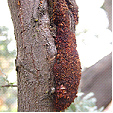 Fruit tree moth borer damage
Fruit tree moth borer damage
The adults female of a fruit tree moth borer normally deposits eggs in damaged areas of the bark or where there is and existing active site. The larvae vary but generally they are creamy to brown, thick soft grub-like reddish brown, and up to 40mm in length.
The adults are white, satiny moths with 40-60mm wingspans with their black abdomens fringed with orange-brown hair or beetle lava that has been deposited in the bark or twigs then tunnels the host.
American Plum Borer (Euzophera semifuneralis) lava is pinkish white to brownish green and attacks the inner bark and cambium region of the tree causing premature death. It is normally found on Platanus orFraxinus species and may also infest many species of fruit trees.
Apple Root Borer (Leptopius squalidus) female adult is a weevil to 20mm long and feeds on the leaves and the plump, legless grub-like lava feeds on the roots of the same host forming tunnels in the deep roots. It is commonly found on Acacia and Eucalyptus species damaging the anchorage of the plant.
Banksia Borer (Cyria imperialis) adult is a black beetle with yellow markings on its wing covers growing to 15mm long. The thickish legless lava is white, tapering from the head and forms flattened tunnels into the heartwood of the host.
Bronze Birch Borer (Agrilus anxius) is a bronze coloured beetle up to 14mm long and lays eggs in crevices in the bark. The legless white larva grows to 20mm long and feeds on the sapwood girdling the branch with flat irregular galleries.
Cedar Tree Borer (Semanotus ligneus) is a black beetle with orange and red markings on its wing covers and grows to 12mm long. The larva feeds on the sapwood of Sequoia, Thuja species and Pinus radiata with curved tunnels that may girdle branches.
Chestnut Borer (Agrilus bilineatus) adult is a tiny slender, blackish green beetle up to 8mm long emerging during spring. The small white larvae have a flat head and are up to 15mm long, forming galleries under the bark of Quercus species.
Cypress Bark Beetle (Phloeosinus cupressi) adult is dark brown with a blackish head, oblong in shape up to 3mm long. The tiny beetles tunnels under the bark of the host and deposits eggs. After hatching the tiny 4mm long, legless larvae bore into the heartwood damaging the tree. After they pupate in the tunnel they emerge through small round holes, commonly many together on the trunk. Damaged trees show signs of browning and dead leaves in the upper branches or falling damage twigs. Cupressus species are particularly vulnerable to attack.
Deodar Weevil (Pissodes nemorensis) is brownish with an obvious snout feeding on the cambium layer and deposits eggs in the bark of the leader and branches. The white lava tunnel the wood eventually killing the leader.
European Corn Borer (Pyrausta nubilalis) is a small moth that lays up to twenty eggs on flower buds. The young flesh coloured larvae mature to a reddish brown and each of its segment has four, spined dark spots.
Elephant Weevil (Orthorhinus cylindrirostris) is a grey or black insect up to 20mm long and lays eggs in the bark near the base of stressed trees. The larva tunnels its way through roots or trunks depositing frass as it goes, then emerging from a second round hole. The adults eat strips from the leaves, normally not bothering the plant.
Elm Borer (Saperda tridentate) adult is a greyish beetle with red bands and black spots on its wing covers and is up to 12mm long. The eggs are laid on the bark and the whitish lava tunnels into the bark and sapwood where it overwinters. It is normally found on Ulmus species.
Iris Borer (Macronoctua onusta) is born from a grey moth with a wing span up to 30mm across, and lays eggs that overwinter in old leaves and debris. As the leaves emerge the eggs hatch entering the leaves at the base, visually forming tunnels and growing to 30mm long. In the later season flower buds may be attacked. Both flowers and leaves eventually turn brown and die.
Lilac Borer (Podosesia syringae) adult is a wasp-like moth that produces pure white lava with a brown head that are up to 25mm long. It initially feeds in the sapwood causing wilting before tunnelling the hardwood making the branches brittle. Evidence of frass is found at the tunnel entrance and secondary fungal attacks infect the holes. Normally found on Syringa species.
Locust Borer (megacyllene robiniae) adult is a black beetle with golden spots, up to 20mm long and produces a small larva that tunnels galleries into the sapwood causing a blackish discolouration. Robinia species are normally attacked.
Mottled Borer (Cryptorhynchus lapathi) attacks Salix species. The adult beetle is black up to 10mm long and the lava bore into the surface of the stem causing swollen growth. Salix species are attacked.
Murry Pine Borer can be two species (Diaoxus erythrurus) and (Diaoxus scalaris). The adults are glossy green-brown beetles that are up to 20mm long and the white grub-like lava is legless, tapering from the head. They tunnel into the sap or hardwood of the trees forming connecting galleries causing ringbarking and creating brittle branches, commonly fond on Callitris species.
Peach Borer (Sanninoidea exitiosa) is a larva that tunnels roots causing gummosis that is mixed with frass at the crown just below soil level. The affected Prunus species produce yellowish leaves and grows poorly. There is another borer, Lesser Peach Borer (Synanthedon pictipes) which attacks any part of the plant from the trunk to the branches and is found on several Prunus species.
Puriri Moth (Aenetus Virescens) a New Zealand short lived moth that grows with a wing span of over 100mm (4in) wide laying eggs on the forest floor at night during spring. The caterpillars grow to 100mm long feeding on leaves and then ascending into the trees and entering the cambium layer up to 150mm deep forming a characteristic '7'-shape burrow that is concealed by frass. The caterpillar may live for 7-years before pupating and collectively they ring bark branches or trunks causing dieback.
Many New Zealand plants including Nothofagus solandri, Pomaderris spp.and ornamentals such as Quercus spp. Betula pendula, Salix spp. Populus spp. Acer spp. Citrus limon and Paulownia spp. are attacked. Control is difficult and generally the plants tolerate attack.
White Pine Weevil (Pissodes strobi) lava feed on the inner bark and sap wood of terminal shoots causing ringbarking and death of the shoot. The reddish brown beetle up to 6mm long is mottled in white and emerges during early summer then lays yellowish lava that are up to 9mm long.
Scribble Moth (Ogmorgraptis scribula) is a grey moth up to 0.4mm wide and produces a cream to brown larvae that is also about 0.4mm long and tunnels in the bark causing a scribble effect. This normally has no detrimental effect on the tree.
Spotted Hemlock Borer (Melanophila fulvoguttata) adult is a colourful metallic beetle with yellowish red spots on the wing covers and lays eggs in cracks in the bark. The white lava is up to 14mm long and forms galleries in the bark and sapwood of the host.
The large Swift Moth and Wood Moths can have a wing span up to 250mm wide and produce large larva that are grub like up to 150mm long, some with horny plates on the thorax. These larvae bore tunnels that are up to 30mm across straight through the heartwood of the host plant. The larvae may live in the tunnel for up to five years before pupating.
Red Cedar Bark Beetle (Phloesinus dentatus) is a small beetle up to 3mm long and lays its larva in excavations in the bark. When the larva emerges they bore galleries in the bark and tend to be more prevalent in stressed or recently transplanted plants.
Vegetable Weevil (Listroderes difficilis) is found during cooler weather (spring or autumn). The adult brown beetle up to 19mm long with a "V" mark on its back and the eggs are laid in the soil around the base of the host plant. The cream coloured lava emerges in spring after rain and feed on the lower leaves forming irregular holes or chewing holes in stems. The lava also feed on fleshy roots boring holes into carrots. Both the adults and lava cause damage, feeding on the plant during the night and resting at the base or under ground during the day. The lava pupates in the soil over winter.
Wattle Web-covering Borer (Cryptophasa rubescens) adult is a satin coloured moth that is up to 50mm across and deposits green fleshy lava that is up to 35mm long. The lava forms shallow tunnels in the bark and sap wood of the host and camouflages it with chewed wood and faeces that is webbed together. Commonly seen attacking the branches on Acacia species.
Life Cycle
These insects have normally have a Holometabolous life cycle. But some borers such as Termites have a Hemimetabolous life cycle.
Eggs are laid singly or in groups, in damaged areas of the bark and branch. Larvae shelter in tunnels they create in the wood and some species may take many years to pupate and emerge as an adult. This may take place in live or dead wood. Other species such as Corn Borer can have up to two generations per year.
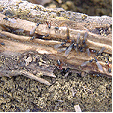 Termites and their damage
Termites and their damage
Distribution of the Pest
Borers are found throughout the world with many species found in Australia both on the coast and inland.
Period of Activity
Varies with the insect concern. Many larvae can be active for many months. Termites are active all year.
Damage Caused
Most damage appears on branches or trunks where the larvae feed on the soft tissue and extensive feeding may cause ring-barking. Normally plants survive borer attack but repetitive attack will cause the death. Certain species are a serious pest in plantations or monocultures such as the Pine Bark Weevil, and the Sirex wood wasp.
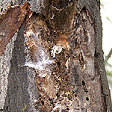 Typical borer damage by a moth larva
Typical borer damage by a moth larva
Chestnut Borer feeds on the sap wood ringbarking large branches and overwinters in the tunnels.
Corn Borer feeds on flower buds and leaves resulting in there death, after which the larva tunnel down the stem causing wilting. There are many crop plants and ornamentals that are affected by this larva.
Swift Moth and Wood Moths weaken trees by boring large tunnels through the branches that may not be noticed until holes are cut through the bark during emergence.
Iris Borer damages leaves to turn brown and wilt, flowers also turn brown and with the aid of a bacterial rot, collapse and die. This damage may be extended to the flower stalk.
Stem Borer (Papaipema nebris) is a small lava to 12mm long, and attacks many garden plants including Lilium, Aster, Alcea and Phlox species
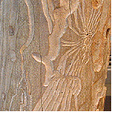 Borer Damage
Borer Damage  Resin oozing from a trunk
Resin oozing from a trunk
Susceptible Plants
There are many plants that are attacked by these pests including Banksia, Callistemon, Melaleuca, Lagerstroemia, Jacaranda species, and flowering stonefruit. Eucalyptus, Acacia species and many ornamental such as Acer species. Plants that are stressed, are particularly venerable.
Acacia and Eucalyptus species are attacked by Swift Moths and Wood Moths.
Acacia species are susceptible to attack from the Wattle Web-covering Borer (Cryptophasa rubescens), which weakens and causes die back of branches.
Acer platanoides is attacked by the Leaf Stalk Borer (Nepticula albostriella) that tunnels into the petiole of the leaf turning it blackish and also attacks the fruit.
Acer saccharinum is attacked by the Petiole Borer (Caulocampus acericaulis) which tunnels in the petioles. It generally attacks the leaves on the lower branches causing them to fall.
Acer species may also be attacked by several borers including the Flat Headed Borer (Chrysobothris femorata), a 25mm long lava of a coppered coloured beetle, that tunnels galleries under the bark girdling the trees The Sugar Maple Borer (Glycobius speciosus) which girdles branches killing them and the Leopard Moth (Zeuzera pyrina) lava that tunnels large holes into branches making them structurally weak. This lava can grow to 80mm long and 12mm thick overwintering in the tunnels.
Banksia species are attacked by the Banksia Web-covering Borer (Xylorycta strigata) a greenish lava up to 40mm long that tunnels down the centre of branch tips. The entrance is covered in silken web littered with faecal material and causes the death of the branchlets.
Betula and Populus species are attacked with the Bronze Birch Borer (Agrilus anxius) and heavy infestation may kill the tree. Populus species are also attacked by the Poplar Borer (Saperda calcarate).
Brachychiton species are attacked by the Kurrajong Weevil (Axionicus insignis) the lava of this plump greyish weevil is white and legless, entering the plant through wounds forming rounded tunnels that may girdle the tree, killing it.
Carya species are attacked by the Painted Hickory Borer (Megacyllene caryae). The adult dark brown beetle has obvious zig zag lines on its wing covers and the lava is cream coloured, both up to 20mm long. The lava tunnels the sapwood of living trees causing ring barking and also tunnels dead trees.
Cornus species are attacked by several borers such as the Flat Headed Borer (Chrysobothris femorata) and the Dogwood Borer (Thamnosphecia scitula).
Cupressus species are attacked by the Cypress Bark Beetle (Phloeosinus cupressi) causing the branches to turn brown and die off from the top or causing the leaves to wilt. On first indication of infestation selective prune off damaged areas or remove the tree.
Hakea sericea and other Hakea species are attacked by the Web-covering Borer (Neodrepta luteotactella). The larvae bore into the twigs and fruit forming a small covering of frass. This insect also infects Macadamia species. Hakeas are also attacked by several other web-covering borers.
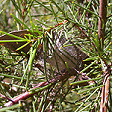 Hakea sericea
Hakea sericea
Pinus and Picea species are attacked by the White Pine Weevil (Pissodes strobi) in the northern hemisphere.
Samanea saman is attacked by the borer (Xystrocera globosa) which chews into the sap wood of stressed trees and can cause serious damage.
Sorbus aucuparia is attacked by the Round Headed Borer (Saperda candida) which forms galleries in the trunk at ground level, forming round holes in the bark.
Tilia species are attacked by the European Bark Borer (Chrysoclista linneela), which feeds on the bark and thew Linden Borer (Saperda vestita) that attacks the base of the trunk or roots.
Tsuga species are attacked by Spotted Hemlock Borer (Melanophila fulvoguttata).
Vaccinium ovatum is infested by the Azalea Stem Borer (Oberea myops). The yellowish lava of this beetle bores into the tips of stems during the flowering period and is up to 12mm (½in) long. It is also commonly found on Rhododenron species.
Control
Cultural Control
Larvae may be destroyed after exposure by pulling away the covering pad of frass, or by pushing a length of wire into the tunnel. Damaged branches may be removed. Improve the culture by feeding and watering the plant.
 Frass due to the Fruit tree moth borer
Frass due to the Fruit tree moth borer
Biological Control
No effective biological control though certain species of trees exude gum or resin sealing the holes and limiting the activity of the larvae or causing its death.
Chemical Control
There is no satisfactory chemical control most borers of live wood.
Note
It is your responsibility by law to read & follow the directions on the label of any pesticide
PEST
NAME
Tip Borer
Various Tip Borer Species
ORDER
Various
Description of the Pest
There is many species of moths which are brown, blackish or white up to 30mm long. Generally the fleshy, greenish to cream coloured larvae grow to 25mm long and are sparsely hairy. The Callistemon Tip Borer is laid by a metallic to blackish moth and the larvae are creamy grubs that have true legs. Some larvae are very active when disturbed such as the fleshy Macadamia Twig Girdler which has darker strips on its body and a dark head.
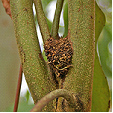 Dieback Borer Damage
Dieback Borer Damage
Dieback Borer (Platyomopsis armatula) adult is a grey-brown beetle up to 20mm long with small lumps on its wing covers and long antennae. The 15mm long cream coloured larva tunnel under the bark and feed on the sapwood causing ringbarking. The entrance to the tunnel is covered in frass and plants in the Myrtaceae family such as Eucalyptus species are susceptible.
Elm Twig Girdler (Oberea tripunctata). The adult beetle feeds on twigs causing girdling then deposits eggs during spring. The lava tunnels down the centre of the stem from the girdled point and overwinters in the tunnels. Twigs up to 14mm diameter may snap off at the damaged point and Ulmus species are normally the host.
Mahogany Shoot Borer (Hypsipyla grandella). The adult is a greyish-brown moth with a wingspan up to 45mm with the wings and veins distinctly overlayed in black. It deposits oval eggs that are tiny 0.50mm wide normally deposited in the leaf axil and change colour from white to red in the first 12 hours. In 3 to5 days the larvae emerges and can grow to 25mm long and is brownish white when young and maturing to bluish with a brown head capsule. Swietenia species are damaged as the larvae bore into the new shoots normally during spring or during the rainy season. The shoots and branches wilt then collapse. This is a major economic pest for cultivated trees.
Red Cedar Tip Moth (Hypsipyla robusta) adult is a grey moth with a wing span up to 20mm across and produces fleshy lava with true legs up to 20 mm long that tunnels into the tips of twigs. The tunnels are surrounded by webbing that is littered with pelleted droppings and is normally found on Toona species.
Staghorn Borer larvae grow to 15mm long and are greyish with true legs and the grey adult moth has a wingspan up to 20mm across. It attacks Platycerium species by eating tunnels into the sterile fronds.
Appearance and Distribution of the Pest
They are found mainly on the coast but also inland and are distributed by flying with the assistance of wind.
Life Cycle
These insects have a Holometabolous life cycle, ie. When metamorphosis is observed during the pupal stage.
Eggs are laid in bark on the growing tips. Larvae shelter in tunnels they create in the wood, up to 20mm deep.
Period of Activity
Active throughout the year in warm climates and are commonly found from tropical to sub-tropical and temperate regions.
Damage Caused
Generally the symptoms of tip borers is yellowing and curling of the leaves which wilt then die or shoots become blackened and are noticeable in the tree. Extensive feeding by a number of larvae causes dieback but normally, this is a minor pest.
The larvae emerge from their tunnels at night, to feed on the bark around the entrance holes. Entrance holes are covered by a layer of chewed wood fragments ("frass") and silk webbing. Most damage appears on twigs and new growth.
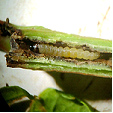 Typical larvae
Typical larvae
The Callistemon Tip Borer tunnels down the centre of the twigs causing then to die or break off and the Macadamia Twig Girdler (Neodrepta luteotactella) form tunnels in sapwood that are covered in fine webbing that is dotted in brown excreted pellets. This is the same appearance as the Banksia Web-covering Borer (Xylorycta strigata) larva makes, as it tunnels down the centre of shoots.
Susceptible Plants
Many native and ornamental plants are susceptible to tip borers such as Callistemon, Melaleuca, Banksia, Hakea, Macadamia and Stenocarpus species
Eucalyptus, Callistemon, Corymbia, Leptospermum and Melaleuca species are attacked by the Dieback Borer (Platyomopsis armatula). Twigs and small branches are attacked and the larvae causes ring bark. Affected branches break easily in high winds.
Sambucus, Yucca and Delphinium species are attacked the Common Stalk Borer (Papaipema nebris) which attacks the stems causing the plant to wilt and topple over.
Cultural Control
Larvae may be destroyed after exposure by pulling away the covering pad of frass, or by pushing a length of wire into the tunnel. Damaged branches may be removed, or tunnels plugged. Infested perennials or annuals should be removed and destroyed.
Biological Control
No effective biological control.
Chemical Control
Spray with Carbaryl (including the trunks or stems) if necessary while the insects are active.
Note
Always read the label for registration details and direction of use prior to application of any chemicals.
PEST
NAME
Red Scale (California red scale)
Aonidiella aurantii
ORDER
Hemiptera
FAMILY
Diapididea
Description of the Pest
Red scale is a hard or armoured scale, with piercing and sucking mouth parts. The adult female has a circular, red to orange/pink conical scale appearance, approximately 2mm in diameter. The male is narrower, grey and relatively inconspicuous. On maturity, it emerges winged from beneath the scale covering. Red scale does not produce the honeydew.


Appearance of the Pest
All parts of the plant above the soil may be attacked. Red scale tends to favour well-lit positions in the canopy of trees. Saplings in open positions may be heavily infested.
Period of Activity
The nymphs are active for most of the year, in warm climates.
Susceptible Plants
Susceptible plants include citrus, wattles, willows, holly, and many ornamentals, such as roses and camellias. Small trees and saplings that are heavily infested may be seriously damaged or die.
Aucuba species are attacked by the Yellow Scale (Aonidiella aurantii) a yellow form of Red Scale. It damages the leaves and allows fungal leaf spots to infect the plant.
Damage Caused
Leaves become yellow and are shed prematurely. Bark on infested stems may crack and exude gum; there may be twig or stem die-back. When the infestation occurs on fruit, the fruit is small and its skin becomes pitted and cracked.
Control
Spray the entire plant with dilute white oil solution; a follow-up spray may be required after four weeks, for heavy infestations. Dead or damaged parts of the plant should be removed and destroyed. Natural predators such as parasitic wasps may reduce numbers of active nymphs; parasitic wasps are bred commercially in some areas for this purpose. It should be noted, however, that wasps will avoid dusty conditions.
Some chemical controls, such as methidathion, are available - please seek advice from your local nursery as to the suitable product for your area.
Note
Always read the label for registration details and direction of use prior to application of any chemicals.
PEST
NAME
Cup Moth
Doratifera species
ORDER
Lepidoptera
FAMILY
Limacodidae
Description of the Pest
The plump larvae are rectangular, 25mm in length, and primarily green in colour, with brightly-coloured stripes and patterns down the back. They have a pair of protuberances (turret-like) at each end of the body that contain a double row of retractable, stinging hairs, which cause a painful skin irritation if touched. The adult is a pale brown, furry moth with a 30mm wingspan.
Appearance and Distribution of the Pest
A native Australian species and is found from temperate to tropical regions. There are simular pests but different species in the USA.
Life Cycle
These insects have a Holometabolous life cycle, ie. When metamorphosis is observed during the pupal stage.
The larvae pupate in a hard, egg-shaped "cup", which is attached to the twigs of the host. The cup has a lid, which the moth removes to emerge.
 Early Larval Stage
Early Larval Stage 
Period of Activity
Most active during Spring and Summer. Outbreaks are sporadic, with large numbers appearing in some years.
Damage Caused
Initially the gregarious young larvae skeletonise the leaves, but as they mature the caterpillars are solitary and feed on the entire leaf; heavy infestations may defoliate large trees.
Susceptible Plants
Eucalyptus, Callistemons and Melaleucas species are the main hosts of this insect. Lophostemon confertus is also commonly attacked.
Cultural Control
Remove by hand (wear hand protection).
Biological Control
Parasitic wasps make no significant difference to numbers.
Chemical Control
Spray small trees with a contact or systemic insecticides during heavy infestations.
Note
Always read the label for registration details and direction of use prior to application of any chemicals.
PEST
NAME
Scale Insect
Various Scale Species
ORDER
Hemiptera
Description of the Pest
Generally scales are soft bodied insects that have a hard (armoured) or soft covering to hide under. They have piercing and sucking mouth parts that are attached to the host, feed off sap and soft scales commonly producing sweet honeydew, which in turn attracts sooty mould and ants.
The adult female has a circular or oval covering depending on the species and is up to 8mm across. The first stage (crawlers) hatch and wander around the leaf surface until finding a suitable place to suck sap, normally in colonies and the smaller male is relatively inconspicuous.
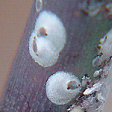 Hard Scale
Hard Scale 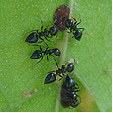 Soft Scale, attending Ants
Soft Scale, attending Ants
Cactus Scale (Diaspis echinocacti) has a circular greyish female and a narrow white male scale and is commonly found on house plants.
Chain Scales (Pulvinaria species) adult females are obvious with large group of eggs that are white or cottony-like, and the tiny young light green scales are flat and oval-shaped up to 2mm long. The legged nymphs are normally arranged from head to tail along the mid rib of the leaf, and may move to a new position to feed. They excrete honeydew and attract sooty mould and are found on Acacia and Acronychia species.
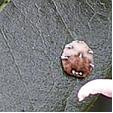 Chinese Wax Scale
Chinese Wax Scale
Chinese Wax Scale (Ceroplastes sinensis) is a domed wax scale that has dark spots around its margin and immature scales form waxy material around there margins.
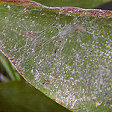 Fern Scale on Aspidistra elatior
Fern Scale on Aspidistra elatior
Fern Scale or Coconut Scale (Pinnaspis aspidistrae) appears as flecks up to 0.15mm long with a white covering over the male congregating on the underside of the fronds on the axils and among the sporangia causing them to turn yellow. Many species of fern are susceptible to infestation.
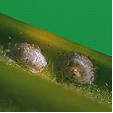
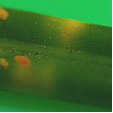 Flat Brown Scale
Flat Brown Scale
Flat Brown Scale (Eucalymnatus tessellates) are light brown up to 0.5mm long, flat and closely attached both sides of the leaf and causing yellowing of the foliage.
Juniper Scale (Diaspis carueli) is tiny and circular, white maturing to grey-black and as it feeds the needles turn yellow and die.
Oleander Scale (Aspidiotus hederae) is a pale yellow circular scale up to 3mm across and is found in dense colonies on the stem or leaves.
Tea-tree Scale (Eriococcus orariensis) are a creamy blue colour normally packed along the branches and are plump and rounded to 4mm across.

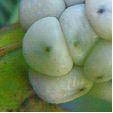 Wattle Tick Scale
Wattle Tick Scale
Tick or Wattle Scale (Cryptes baccatus) adult is domed, blue-slate colour with a leathery covering up to 10mm long. All stages of growth are found in groups of over forty, packed along the stems and normally tended by ants as they produce large amounts of honeydew. A serious pest of Acacia species found inland or coastal from temperate to sub tropical climates and commonly accompanied by Sooty Mould.
Toxic Scale (Hemiberlesia lataniae) is a tiny flat rounded scale up to 0.15mm long and is white to pale pink. It is normally found in colonies on the small branches and twigs of shrubs. It injects a toxic substance into the host as it sucks sap causing the death of the branch.
Wattle Scale (Pseudococcus albizziae) is soft, plump and secrets cotton-like threads. It is not a true scale insect and is simular to mealy bugs. It is reddish-brown up to 0.4mm long and secrets large amounts of honeydew as it sucks sap in colonies along the branches.
Life Cycle
These insects have a Hemimetabolous life cycle, ie. When the immature nymphs resemble the adults.
Appearance of the Pest
All parts of the plant above the soil may be attacked, but normally the stems and leaves and scale tends to favour well-lit positions.
Period of Activity
The nymphs and females are active for most of the year, in warm climates. Once they selected a position they attach and don't move. Normally the winged or wingless males are mobile and only soft scales produce honeydew.
Susceptible Plants
There is a wide range of susceptible plants including citrus, willows, holly, and many ornamentals, such as roses or Paeonia species. It also attacks indoor or glasshouse plants and Australian native plants such as wattles, hakeas, grevilleas and eucalyptus.
Acacia species are attacked by the Tick or Wattle Scale, which infest twigs and small branches and heavy infestations will kill the host plant.
Acer species are attacked by the Cotton Maple Scale (Pulvinaria innumerabilia) which prefers Acer saccharinum. Nymphs first attack the leaves and the brown adult scale is covered in a woolly mass up to 14mm across, normally found on the underside of the stems and twigs.
Acmena smithii, Melaleuca, Syzygium and Pittosporum species are attacked by the Chinese Wax Scale.
Aesculus species are attacked by several scale insects including the Walnut Scale (Aspidiotus juglans-regiae) which is saucer-shaped and attacks the main trunks.
Agave species are susceptible to several types of scale including (Aspidiotus nerii), (Aonidiella aurantii) and (Pinnaspis strachani), but generally do not require control.
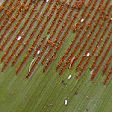 Asplenium australasicum
Asplenium australasicum
Asplenium australasicum is susceptible to Coconut Scale or Fern Scale (Pinnaspis aspidistrae). It is normally found on the under side of the fronds. Small infestations cause little damage.
Bougainvillea species may be attacked by the soft scale (Coccus hesperidum) outdoors or under glass.
Calluna and Vaccinium species are attacked by the Oyster Shell Scale (Lepidosaphes ulmi).
Camellia species may be attacked by the Florida Red Scale (Chrysomphalus aonidum), which is small, circular and black and is found firmly attached to the underside of the leaf along the veins. On inspection after removing the scale the insect has a pale yellow body. Camellias are also attacked by a large variety of scale insects including Tea Scale and Camellia Scale.
Carpinus species may be attacked by the scale (Phenacoccus acericola). It is found on the underside of the leaves forming a white cotton-like clump along the veins.
Casuarina and Allocasuarina species may be attacked by the Casuarina Scale (Frenchia casuarinae), a black hard scale that is upright to 4mm with a pinkish body. During attachment the surrounding tissue swells up and in time can, form galls. This weakens the wood and in severe infestations may kill the tree.
Cotoneaster species are attacked by up to four species of scale including the Oyster Shell Scale (Lepidosaphes ulmi).
Cupressus species are attacked by Bark Scale (Ehrhornia cupressi) is pink and covered in white wax. Heavy infestations cause the leaves to turn yellow or reddish.
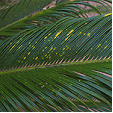 Flat Brown Scale on Cycas revoluta
Flat Brown Scale on Cycas revoluta
Cycads, palms and some species of Callistemon are attacked by the Flat Brown Scale.
Erica species are attacked by several species of scale including, Greedy, Oleander and Oystershell scale.
Jasminum species can be infested with up to twelve types of scale.
Juniperus x media and other conifer species are attacked by the Juniper Scale.
Leptospermum species are attacked by the Tea-tree Scale which produces ample honey dew that promotes sooty mould.
Palm and Fern species are susceptible to attack by the Coconut Scale or Fern Scale (Pinnaspis aspidistrae) which infests the underside of the leaves. They are also hosts for many other scale species such as red, cottony cushion and tea scale.
Pinus species are attacked by several species of scale including the Pine Tortoise Scale (Toumeyella numismaticum) and the Red Pine Scale (Matsucoccus resinosae).
Polygonum odoratum is attacked by a small brown scale.

Sorbus aucuparia is attacked by a five species of scale insect, including Black Cottony Maple, San Jose and Scurfy. Generally they suck on the sap of the new growth and leaves.
Strelitzia species are attacked by the Greedy Scale (Aspidiotus camelliae).
Damage Caused
Leaves become yellow and are shed prematurely and there may be twig or stem die-back. When the infestation occurs on fruit, the fruit is small and its skin becomes pitted and cracked. Small trees and saplings that are heavily infested may be seriously damaged or die. Sooty mould can cover fruit or leaves causing a secondary problem.
Cactus Scale can completely cover the host cactus sucking sap and causing it to die.
Cultural Control
Dead or damaged parts of the plant should be removed and destroyed including fallen fruit. Small infestations may be removed by hand or squashed on the stems. Healthy plants are less susceptible to attack, so maintain vigour of the plant and avoid using high-nitrogen fertiliser that produces excessive soft young growth.
When pruning susceptible plants paint the cuts with antifungal sealant paint as scale insects are attracted to the sweet smell of the sap. This will reduce the infection rate of the plant.
Biological Control
Natural predators such as parasitic wasps may reduce numbers of active nymphs; parasitic wasps are bred commercially in some areas for this purpose. It should be noted, however, that wasps would avoid dusty conditions.
Other predators that assist in control are assassin bugs, ladybirds, lacewings, hover flies and scale eating caterpillars. A variety of birds also attack scales.
The control of ants that transport aphid from one host to another also reduces infestation and can be carried out by applying at least three greased bandages 5mm apart around the stem or trunk of the plant.
Chemical Control
Spray the entire plant with dilute white oil solution; a follow-up spray may be required after four weeks, for heavy infestations. Spraying of chemicals will also kill of natural predators and in some cases the secondary scale infestation is more prolific especially when using copper based chemicals.
Some chemical controls, such as methidathion, are available - please seek advice from your local nursery as to the suitable product for your area.
Note
Always read the label for registration details and direction of use prior to application of any chemicals.
PEST
NAME
Frog Hopper (General)
Various Frog Hopper Species
ORDER
Hemiptera
Description of the Pest
Generally frog hoppers grow up to 15mm in length, and look simular to small cicadas, but capable of hopping. The adults construct conical tubes that are attached to branches from the narrow end. The larvae live inside the tube emersed in secreted fluids that protecting it from predators and attracts ants. Both nymphs and adults have piercing and sucking mouth parts.
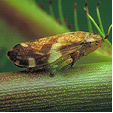
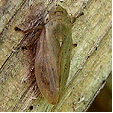
The Common Froghopper (Chaetophyes compacta) is 8mm long. Females are brownish and the males are black. It feeds solitary or conjugate in colonies. Adults can fly but will hop away immediately if disturbed.
Appearance and Distribution of the Pest
The adults and nymphs are present throughout the year in tropical to warm temperate regions and are dispersed by flying.
Life Cycle
These insects have a Hemimetabolous life cycle, ie. When the immature nymphs resemble the adults.
Females deposit eggs in tubes that are attached to the host, and several generations may appear annually on the same plant.
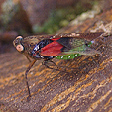
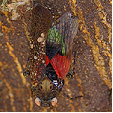 Frog Hopper with missing wing cover.
Frog Hopper with missing wing cover.
Damage Caused
Nymphs and adults are gregarious, and both stages may be found on host plants at the same time. If large numbers attack young new growth, sucking sap from leaf petioles and young stems, the host plant may become stressed. Severe infestations may weaken and eventually kill the plant.
The nymphs exude a sweet secretion, which is attractive to ants that attend and protect the colony. The honeydew also causes sooty mould to occur as a secondary problem.
Susceptible Plants
Most Eucalyptus species, Acacia species, Casuarina species and many other native or ornamental plants.
Cultural Control
Improving the culture of the host species may assist in maintaining vigorous growth, to minimise shock from infestations. It may be possible to remove them by hand from young trees, using a small butterfly net.
Biological Control
Controlled by natural predation.
Chemical Control
Under normal circumstances, it is impractical and unnecessary to treat mature trees however, Frog hoppers on young plants may be treated with a contact insecticide.
Note
Always read the label for registration details and direction of use prior to application of any chemicals.
PEST
NAME
Painted Apple Moth
Teia anartoides
ORDER
Lepidoptera
FAMILY
Lymantriidae
Description of the Pest
Adult males are 25mm long and have a 25mm wingspan, with brown forewings and yellow hindwings with black edges. Females are also 25mm long, but wingless. Larvae are furry brown caterpillars, up to 30mm long, with four prominent tufts of reddish brown hair behind the head, and two horn-like tufts of black hair projecting forward. The caterpillar's hair may cause skin irritation.
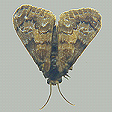
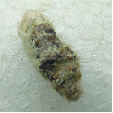 Wingless Female
Wingless Female
Appearance and Distribution of the Pest
An Australian native, most commonly found in temperate and subtropical regions. Originally known as the painted wattle moth, feeding exclusively on acacias, it has adapted to feed on apples and other species.
Life Cycle
This insect has a Holometabolous life cycle, ie. When metamorphosis is observed during the pupal stage.
Larvae pupate in loosely woven cocoons; eggs are laid on the empty cocoons.
Period of Activity
May be active all year, particularly during the cooler months.
Damage Caused
Larvae may skeletonise leaves; small plants may be defoliated. Because females are flightless, infestations are localised.
Susceptible Plants
A wide range of plants are affected, including apples, Acacias, Melaleucas, Grevilleas, and many exotics. Some fern species are also attacked.
Rosa species leaves are attacked by larva.
Cultural Control
Remove small infestations of larvae and cocoons by hand.
Biological Control
None known.
Chemical Control
Maldison, Carbaryl or other contact pesticides are effective; a wetting agent is necessary to penetrate the larval hair.
Note
Always read the label for registration details and direction of use prior to application of any chemicals.
PEST
NAME
Plague Thrips, Blossom Thrips
Thrips imaginis
ORDER
Thysanoptera
Description of the Pest
This slender grey insect is up to 1.2mm long and the folded fringed wings appear as silvery stripes. They are difficult to see singularly and the yellowish wingless nymphs are smaller. Both adults and the first two nymphal stages have rasping and sucking mouthparts.


Appearance and Distribution of the Pest
Thrips are found from tropical to temperate regions of Australia preferring a cool mild winter followed by a dry sunny spring that produces abundant flowers. It is dispersed by flying and can be carries great distances on the wind.
Life Cycle
This insect has a Hemimetabolous life cycle, ie. When the immature nymphs resemble the adults.
The female adult lays her eggs using an oviposit in a slit on flower stems or occasionally leaves. The eggs develop into four nymphal stages. The first two stages occur on the plant and the last two in the surrounding soil or in leaf litter, emerging as adults and flying to reinfect the plant. It takes ten to thirty days to develop from egg to adult depending on the temperature and rainfall. Under opium conditions thrips are produced in plague proportions.
Period of Activity
Thrips are most active during warm dry, calm weather, but dislike the soil to be too dry or wet.
Damage Caused
Thrips congregate inside the flowers damaging the epidermal layer, allowing sap to leak out. This causes the flower petals to become brownish and curl along the margins. The effect is a reduction in fruit and seed production on the host plant.
Susceptible Plants
Plants that produce buds and petals that are soft are at most risk, such as Alyogyne species, Baeckea species, Hibbertia species, Hibiscus species and Leptospermum species. There is also a wide range of ornamentals, apples, pears, citrus, stonefruit, grapes and strawberries that are attacked.
Cultural Control
There is no satisfactory cultural control. Small infestations may be ignored or the plant may be hosed to reduce the numbers. Removal of surrounding leaf litter, weeds and cultivating the soil can also reduce the numbers and disturb the life cycle.
Biological Control
No effective natural control though heavy rain reduces numbers.
Chemical Control
Thrip can be sprayed with a contact insecticides at least twice every ten days to kill newly hatched nymphs.
Note
Always read the label for registration details and direction of use prior to application of any chemicals.
PEST
NAME
Gall Flies (General)
Various Gall Flie Species
ORDER
Diptera
FAMILY
Cecidomyiidae
Description of the Pest
There is about 100 species of flies that are known as gall gnats or gall midges. They infect particularly the leaves usually forming pimple like galls. The buds and stems are also attacked and the galls can be large.
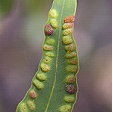 Blossom Gall Fly on Acacia species
Blossom Gall Fly on Acacia species
Blossom Gall Fly (Cecidomyia acaciaelongifoliae) attacks spent flowers heads forming large twisted galls that are made up of tubes containing maggots that feed on the flower heads and causing the seed to become malformed, into galls. Not normally requiring control, but plants appear ugly.
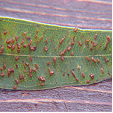
 Pimple Gall on Eucalyptus species.
Pimple Gall on Eucalyptus species.
Pimple Gall (Harmomyia omalathi) forms small reddish pimple-like galls that may appear along the mid rib.
Callitris Gall (Diplosis frenalae) is a large gall that that splits in to six sections and looks very simular to a Callitris cone.
Cone Gall (Rhabdophaga strobiliodes) is produced by a small fly that deposits eggs in opening buds. Lave overwinter in the cone shaped galls that inhibit the development of the bud. It is found on Salix species.
 Fergusonina Galls
Fergusonina Galls
Image by B. Sonsie
Fergusonina Galls (Fergusonina species) are the result of a symbiotic relationship between leaf nematodes and gall flies such as (Fergusonina nicholsoni). In all cases the nematodes are deposited along with the fly's lava and together they feed on the leaves forming galls, which can become large sometimes cover the entire leaf. The nematodes increase in numbers and when the fly emerges it is infested with them, which are then deposited in the new nest completing the cycle.
Appearance and Distribution of the Pest
The adult infect plants from spring to autumn and are distributed by flying with the assistance of wind. The larvae may also be distributed in infected cuttings or leaves that are transported to another site.
Life Cycle
These insects have a Holometabolous life cycle, ie. When metamorphosis is observed during the pupal stage.
The larvae of these insects are known as maggots. They have chewing mouthparts and the adults have piercing and or sucking mouthparts and one pair of wings.
Period of Activity
Generally the flies are more active during the warmer months of the year and are found in sub tropical to temperate regions particularly on the coast.
Damage Caused
When flowers are attacked the maggot interferes with seed formation and stimulates the growth of galls. Many species of Gall Fly feed off the plant from within the gall and certain species such as Fergusonina Galls (Fergusonina species) forms a symbiotic relationship with nematodes and both feed from within the gall. The leaves are the normal area attacked, but stems are also infected such as the new stems in Callitris species.
Susceptible Plants
There are many species attacked including Acacia, Eucalyptus, Callitris, and Pittosporum species.
Catalpa species are attacked by the Midge (Cecidomyia catalpae) which lays eggs in the leaves and the emerging lava eat circular sections of the leaf surface causing distortion.
Eucalyptus species are attacked by various Fergusonina Galls which may alter the flowering or seed production of the host.
Viola species are attacked by the Gall Fly (Phytophaga violicola) which attacks the leaves forming galls and distorting its shape. After time the leaves form wet-rot and the plants development is dwarfed.
Cultural Control
Pick off the damaged leaves where possible prior to the emerging adult and destroy. This will reduce build up of the population, but if there is evidence of emergent holes in the gall it is too late. Plants that are repetitively attacked should be removed and the area re-planted with a less susceptible species. Infected trees respond to fertilising and watering to improve vigour against the attack.
Biological Control
Parasitic wasps lay there eggs in the galls and some species of nematode eats the larvae prior to emergence.
Chemical Control
Chemicals may be injected or sprayed but normally has limited effect as the insect is inclosed within the gall and is difficult to monitor.
Note
Always read the label for registration details and direction of use prior to application of any chemicals.
PEST
NAME
Case Moths, Bag moths
Various Case Moth
Species
ORDER
Lepidoptera
FAMILY
Psychidae
Description of the Pest
Also called the bag moth or bagworm - so called because of the silken, bag or case-like structure in which they shelter and pupate. The pendant case is frequently covered with twigs, pine needles, sand or leaf fragments, which serve to reinforce and camouflage it. The case is enlarged as the caterpillar grows and the upper part of the body emerges for feeding and movement. It withdraws into the case if threatened or disturbed.
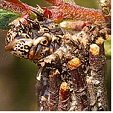 Case moth feeding
Case moth feeding 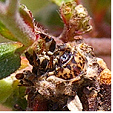 The head protrudes from the case to feed
The head protrudes from the case to feed
Leaf Case Moth (Hyalarcta huebneri) constructs a short cocoon that has a ragged appearance and is covered in leaf and bark pieces. The caterpillar is orange with black bands and can grow to 50mm (2in) long. This pest can be found on Eucalyptus and Leptospermum species, it may also attack palms from sub tropical to tropical regions.
Ribbed Case Moth (Hyalarcta nigrescensi) forms a greyish cocoon that has four prominent ribs and taper at the base. It feeds solitary on Acacia and Eucalyptus species by chewing on the leaves or removing the epidermal layer of the leaf.
Saunders Case Moth (Metura elongatus) forms an elongated silken bag composed of small pieces of twig and is up to 150mm (6in) long. The caterpillar is dark red with yellowish bands and markings. It is commonly seen from temperate to tropical regions feeding on leaves of Eucalyptus, Callistemon and Epacris species. When disturbed it hides in its cocoon and control is not normally required.
 Saunders Case Moth
Saunders Case Moth 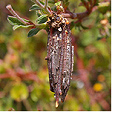 Ribbed Case Moth
Ribbed Case Moth
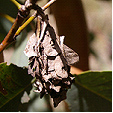 Leaf Case Moth
Leaf Case Moth 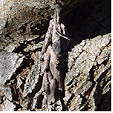 Well Camouflaged
Well Camouflaged
Life Cycle
This insect has a Holometabolous life cycle, i.e. it has a larval and a pupal stage.
The larval stage can last up to 2 years.
The male moths can fly. In some species the females are wingless, or have greatly reduced wings.
In some species the females can lay over 10,000 eggs.
Larvae pupate in their cases. Newly hatched larvae disperse and construct their own cases.
Distribution of the Pest
They are widespread across most temperate to tropical Australia.
Damage Caused
Larvae eat leaves and on masse they may cause considerable damage.
Larvae and their cases are difficult to detect among foliage.
Period of Activity
Larvae are more numerous and active during the warmer months.
Susceptible Plants
A wide range of plants are susceptible to case moth larvae, with different moth species favouring different plants. Host plants include eucalypts, acacias, pines and conifers.
Callitris species are attacked by the Stick Case Moth (Clania ignobilis) that constructs a cylindrical cocoon of aligned twigs with a projecting twig at the base and feeds on small or young foliage. It is not a major pest causing little harm.
Larix species are attacked by the Larch Casebearer (Coleophora laricella). The caterpillar forms a cigar-shaped case from pieces of needles. It feeds on the needles in late spring by forming a hole either end or the middle of the leaves and mining the centre with out leaving its case. It then overwinters in its case attached to the twigs and the moth emerges in early summer.
Control
Cultural Control
Early detection and control of infestation is important with some species; they may be removed by hand.
Biological Control
Birds are natural predators.
Chemical Control is possible, but this is not usually necessary.
Note
It is your responsibility by law to read & follow the directions on the label of any pesticide
Amendments by B. Sonsie Dip Hort Sc Burnley
PEST
NAME
Sawfly (General)
Various Sawfly Species
ORDER
Hymenoptera
Description of the Pest
Adult sawflies are wasps that have derived the name Sawfly from the sawing action to open leaves using there ovipositor. The adults are usually colourful insects. The fleshy larvae normally are tapering caterpillars, some with pointed spine on the tale and are many different colours from black-blue to brown and orange.
These insects have a Holometabolous life cycle, ie. When metamorphosis is observed during the pupal stage.
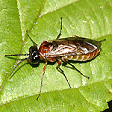

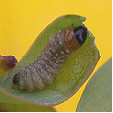
They are commonly called "spitfires" because, when disturbed, they bend back their bodies and exude a strong, eucalyptus-scented liquid from their mouths. This exudate contains concentrated eucalyptus oil, which can cause severe eye irritation. The non-feeding adults are seldom seen. Sawflies have a complete metamorphosis, pupating in cocoons in the soil for months or years.
Eucalyptus Sawfly (Perga kirbyi) lava is pale brown up to 40mm long. It is a plump grub with a black head and a yellow tipped tail and can be found in groups during the day, but spreads out at night to feed. When disturbed they react by arching there head and wiggling there tail.
European Spruce Sawfly (Diprion hercyniae) feeds on the old growth causing stunting of the host and the larvae overwinter in cocoons on the ground.
Ironbark Sawfly (Lophyrotoma interrupta) is a fleshy tapering grub up to 40mm long. It is pale brown with a black head and a yellow tip on its tail.
Long-tailed Sawfly (Pterygophorus insignis) larvae are greenish with a textured surface and a long pointed tail.
Pin Oak Sawfly (Caliroa lineata) adult is shiny-black up to 6mm long with four wings and the greenish larvae is up to 14mm long. It feeds by skeletonizing the underside of leaves turning them golden-brown as they die and an infestation in a large Quercus species is easily recognisable.
Pine Sawfly (Zenarge turneri) lays larvae that are rough and fleshy up to 10mm long with the abdomen curled.
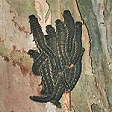 Steelblue Sawfly
Steelblue Sawfly
The adult Steelblue Sawfly (Perga dorsalis) female is steel blue in colour, with yellow antennae and legs, growing up to 20mm long, with 40mm wingspans. The insect is called a "sawfly" because of the sawing action of the ovipositor. The yellowish-brown larvae have chewing mouth parts.
Appearance of the Pest
During the day, sawflies congregate in clusters, separating at night to travel and feed on the foliage of the host plant.
Period of Activity
Caterpillars appear in spring through summer and are found from tropical to sub-tropical and temperate regions.
Susceptible Plants
There are many ornamental and Australian native plants that are attacked including Eucalyptus camaldulensis, E. blakelyi, E. melliodora, and E. pauciflora and Callistemon, Leptospermum species.
Eucalyptus species are attacked by the Eucalyptus Sawfly (Perga kirbyi) which can defoliate a tree.
Larix species are attacked by the Larch Sawfly (Pristiphora erichsonii). The adult wasp-like fly deposits eggs in an incision on the twigs during late spring and the 25mm long olive green spiny larvae chew the needles. The larvae overwinter on the ground in brown cocoons.
Melaleucas are also attracts the Paperback Sawfly.
Pinus and Callitris species are attacked by up to four species including the Pine Sawfly (Diprion simile).
Sorbus aucuparia is attacked by the Mountain Ash Sawfly (Pristiphora jeniculeta). The larvae feed on the leaves, leaving only the mid rib and main veins. Heavy infestations causes serious defoliating of the tree.
Viola species are attacked by the Sawfly (Ametastegia pallipes) which eats the leaves skeletonising them.
Damage Caused
Generally the larva eat the surface of leaves, skeletonising them when young, but as they develop they eat large pieces leaving only the mid rib. They tend to feed on the terminal shoots, and heavy infestations can defoliating young trees.
Cultural Control
Clustering larvae may be hosed or knocked from branches, falling to the ground where they can be squashed under foot or attacked by other predators. At night when the larvae congregate they can be collected and disposed off. In small infestations they can be picked by hand and destroyed.
Biological Control
The exudate causes most birds to avoid the larva, although cockatoos remove the head and oil gland prior to consumption. They are also eaten by lizards and frogs or attacked by parasitic wasps.
Chemical Control
Affected plants can be sprayed using Maldison or Carbaryl, this is only possible for small trees.
Note
Always read the label for registration details and direction of use prior to application of any chemicals.
PEST
NAME
Callistemon Sawfly
Pterygophorus sp P
citrinus
ORDER
Hymenoptera
FAMILY
Pergidae
This pest is the larvae of a wasp. Larvae are shiny greenish brown in colour, with small white spots along the length of the tapering body, which ends in a spike "tail". The insect is called a "sawfly" because of the sawing action of the female ovipositor. The larvae have chewing mouth parts; when disturbed, they bend back their bodies and exude a noxious liquid from their mouths. The larvae feed together and cluster in small groups during the day.
The larvae have more than 5 pairs of prolegs. The Adults do not sting.
 Sawfly feeding in a group
Sawfly feeding in a group  Note the pointed abdomen
Note the pointed abdomen
Life Cycle
This insect has a Holometabolous life cycle, i.e. it has a larval and a pupal stage
Eggs are laid in slits created in the plant tissue; larvae pupate in the ground.
There are many generations per year.
Distribution of the Pest
This Australian pest is most active during the warmer months and the larvae feed in groups.
Damage Caused
Leaves are completely eaten by older larvae. Younger larvae initially skeletonise the leaves.
Susceptible Plants
Callistemon spp. mainly
Control
Cultural Control
Remove by hand; larger numbers may be shaken to the ground or pruned off the plant during the day.
Normally it is the first generation that is the main problem.
Biological Control
Native birds feed on the larvae, in the process knocking many to the ground, where they are eaten by predators.
Chemical Control
Contact insecticides may be considered
Note
It is your responsibility by law to read & follow the directions on the label of any pesticide
Amendments by B. Sonsie Dip Hort Sc Burnley
Syn. name is Lophyrotoma species
PEST
NAME
Nectar Scarabs
Phyllotocus species
ORDER
Coleoptera
FAMILY
Scarabaeidae
Description of the Pest
Adult beetles have a characteristic scarab shape, up to 6mm in length, with exaggerated hind legs. The head and thorax is dark brown; the wings have orange-brown longitudinal striations. Larvae appear as small white curl grubs. Both larvae and adults have chewing mouth parts.
Flower Scarab Beetles (Protaetia apecies). Thiese active beetles are stout and broad up to 20mm long. The colouring is normally brown with some having small pale markings on the wing covers. It is commonly found feeding on Myrtaceae or Proteaceae flowers (pollen) or shoots of Acacia species. It is a solitary feeder and may cause dieback of the host.
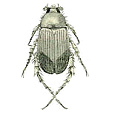
Appearance and Distribution of the Pest
Nectar scarabs are Australian natives but are rarely found in the Northern Territory. They are distributed by flying to a new host plant.
Life Cycle
These insects have a Holometabolous life cycle, ie. When metamorphosis is observed during the pupal stage.
It has a complete metamorphosis producing one generation every one to three years, depending on the species. The eggs are laid during spring normally near the surface of the soil and the lava burrow into the soil. The lava overwinters deep in the soil and pupates during spring.
Period of Activity
Most active during the warmer months, when plants are flowering.
Damage Caused
Larvae feed on decaying vegetable matter and cause little damage. Adults swarm on host plants in large numbers, feeding on pollen and nectar; when swarming they may also feed on the flower parts.
Susceptible Plants
Many plants are attacked by this insect including Acacia, Eucalyptus, Melaleuca and Callistemon species. Ornamentals such as Rosa and Dahlias species are also attacked.
Cultural Control
Small infestations may be removed by hand but certain species such as the Flower Scarab Beetle drop to the ground and pretend to be dead. This is an opportunity to collect them on a piece of plastic if it is spread around the plant.
Biological Control
No known controls.
Chemical Control
Contact insecticides such as Carbaryl are effective, but not normally necessary.
Note
Always read the label for registration details and direction of use prior to application of any chemicals.
Note: Plants affected by this pest are Deer Resistant plants not the susceptible plants.
PEST
NAME
Deer
Cervus species
ORDER
Artiodactyla
FAMILY
Cervidae
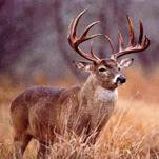
Description of the Pest
There are two species of the deer in North America, the Whitetail (Odocoileus virginianus) and the Mule deer (Odocoileus hemionus) with several regional variations such as the Pacific coastal Blacktail (O.h. columbianus) which is regarded as a sub-species of the Mule deer.
The Whitetail on average grows to 112 cm (44in) tall and 180 mm (70 in) long and weigh 68 kgs (150lbs). The fir colour varies according to its environment but generally it is reddish-brown during summer and grey-brown in winter with a pure white underside on its tail. When the tail is erect it is known as the "white flag". Its antlers consist of two main beams from which the points emerge.
The Mule deer grow to 105 cm (42 in) tall and are up to 200 cm (80 in) long with the adult buck weighing up to 137 kgs (300 lbs) and the does up to 80 kgs (175 lbs). The fir is generally tawny brown during summer and during winter it has a heaver grey-brown to blue-grey coat with a small white tail that is tipped in black. The other distinguishing features are its ears that are up to 300 mm (1 ft) long (mule-like) and its antlers, with the two beams that are forked into smaller beams, which inturn fork again and again.
The Blacktail deer (Pacific coastal Blacktail) grows to 97 cm (38 in) tall and is up to 105 cm (60 in) long and weighs on average 73 kgs (160 lbs). The fir is generally tawny brown during summer and during winter it has a heaver grey-brown to blue-grey coat with a tail that is dark brown at the base then changing to black for 50% of its length. The antlers consist of two beams that are forked into smaller beams, which inturn fork again and again.
Appearance and Distribution of the Pest
The Whitetail deer are found throughout eastern United States, on the coast and inland but are not commonly seen in California, Utah or Nevada. They do not migrate but congregate together (yard up) during winter and feed in a part of their existing territory.
The Mule Deer are found in the western part of North America from South eastern Alaska to Mexico and from the Pacific coast to Texas. They migrate from highland mountain meadows to southern or lower snow free forested valleys during winter.
The Blacktail deer are found on the Pacific coast from Alaska to northern California. There is both resident and migratory Blacktails. The migratory Blacktails move southwards during late autumn at the first sigh of snow or heavy sustained rain and the resident Blacktails seek cover their existing territory amongst woodlands during the winter months.
Life Cycle
All Deer breed from autumn to early winter and the does give birth from late spring to early summer.
Period of Activity
Deer are most active from spring to autumn but can be troublesome during winter when the feed is scarce. In some regions urban landscapes become the major food source both in summer and winter.
Damage Caused
Browsing deer will feed on almost any plant and is most commonly noticeable during spring feeding on the new growth or twigs and stems leaving a shredded appearance. Deer also rub their antlers against trees damaging bark and snapping off small branches, this action also incurs damage under hoof as plants, lawns and garden structures are trampled on.
Susceptible Plants
Some plants are more palatable to deer but when a deer is hungry or during drought conditions there are no "Deer Proof" plants. There is a range of plants that have a bad taste and are not destroyed and are regarded as (deer resistant plants). Deer resistant plants are the plants that are attached to this file not the susceptible plants.
Cultural Control
There are many cultural controls that have been tried to move browsing deer such as frightening them with strobe lights, pyrotechnics or tethered savage dogs. These actions are only temporary and may cause more trouble as the stampeding animals move off. Fencing and netting can be an effective method of discouraging hungry deer from gardens but may be expensive on a large scale and require maintenance. There are several types of fences which include conventional 2.2m (8 ft) deer-proof woven wire fences or single-wire electric fences and slanted deer fences. Plant selection can also be effective, by using less desirable plants (deer resistant plants) as an outer border to the more desirable plant species and thus discouraging the deer to enter the garden. Hedges and windrows of less desirable thorny plants can also be a deterrent to browsing deer.
Chemical Control
There are two main types of repellents contact and area. Contact repellents are applied directly to the plants and deter deer with a bad taste or smell. They can be applied by rubbing or spraying on to the plants and commonly used in an egg mixture. The commercial products have proven to work better than home remedies which include soap or chilli mixtures and hanging bags of human hair.
Area repellents rely on an offensive odour and are placed around areas that are frequently visited.
Contact your local distributor for available types and application.
DISEASE
NAME
Sooty Mould
Various Sooty Mould Species
Description
A fungal problem related to honeydew that is secreted from other insects. The fungus will not infect the host plant.
Symptoms
A soot-like dry black fungus appears on areas of the plant where honeydew is found. The fungus spreads and becomes thick restricting the plants capability to photosynthesize. The fungus can also appear on fruit spoiling its appearance and gives the plant an unattractive look.
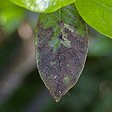
 Gardenia augusta
Gardenia augusta
Source and Dispersal
It is found on other infected plants and soon spreads by wind to other susceptible plants.
Favoured Conditions
It is occurs when insects are producing honeydew, normally through the growing period.
Affected Plants
These fungi can found on most plants particular plants that are infected with scale insect that produces honeydew.
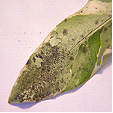 Pittosporum eugenioides
Pittosporum eugenioides 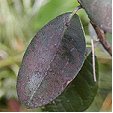 Camellia japonica
Camellia japonica
Callicarpa species are infected with Black Mould (Meliola cookeana) with its black mycelium growing on all parts of the plant including twigs and leaves.
Non-chemical Control
To reduce sooty mould it is required to controlling insect numbers on the plant. Affected plants may have the dry sooty mould rubbed or hosed off.
Chemical Control
Fungicides are not required, but the control of the insect producing honeydew is required.
Note
Always read the label for registration details and direction of use prior to application of any chemicals.
DISEASE
NAME
Grey Mould
Botrytis cinerea, B. elliptica
Description
Grey Mold, Shoot Blight, Petal Blight is a fungus problem that generally forms water-soaked spots that rot and produces greyish sclerotia (fungal resting bodies) on the surface. They can be found throughout the year on dead tissue and on live material during under ideal climatic conditions. Damaged areas such as a tear in a leaf or an opening made by an insect are more likely to be infected.
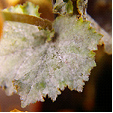 Grey Mold on Begonia species
Grey Mold on Begonia species
Image by B. Sonsie
Symptoms
The fungus attacks stems, leaves, flowers and fruit. In roses the fungus is primarily attacks the flowers producing pink rings on the petals and buds that become brown and rotten. This may extend down the peduncle to the stems causing dieback.
In other plants oval yellowish to brown spots appear, then the centre turns greyish and dries out and in humid weather the spots spread, joining up and infecting the entire leaf. This infection may also occur on the stems, and flowers may form abnormally or brown off and die.
When lettuce is infected it starts at the base causing a soft brown rot that may extend up the stem killing the plant, and pears flowers become infected then spreading to the fruit. This develops a sunken brown area that is soft and eventually is covered in grey powdery spores.
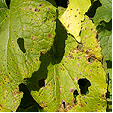
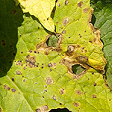 Botrytis Blight on Senecio cruentus
Botrytis Blight on Senecio cruentus
Botrytis Blight (Botrytis tulipae) infects leaves, flowers and stems with flecks of brown spots that merge to form light grey rotted areas that have brownish margin that may destroy stems. Affected areas are covered in a grey mould during humid conditions. The spores overwinter in dark brown sclerotia, which are found on the outer scales of the bulb or at the base of the stem in Tulipa species.
Grey Bulb Rot (Rhizoctonia tuliparum), which infects the bulbs of Tulipa species, attacking the base of the leaves and rotting the bulb. When bulbs emerge during spring in infected soil's they soon die off. The greyish mold tends to be dry.
Source and Dispersal
The sclerotia (fungal resting bodies) are found on dead plant material or in the soil and remain viable for many years. The spores are dispersed by wind or splashing water.
Favoured Conditions
It prefers cool moist climate with morning dew.
Affected Plants
Grey Mold attacks a wide range of plants including roses, fruit trees, pelargonium, ferns, grapes and cyclamens. Heliotropium , Amaryllis, Lilium and Hippeastrum species are also infected.
Agave species are infected by two fungal Leaf Blights (Botrytis cinerea) and (Stagonospora gigantea) that severely damage the leaves particular during wet periods or from excessive watering.
Cactus species are infected by soft rot or Grey Mould (Botrytis cinerea). Stems and pads turn are greyish with the upper surface, rotting then collapsing. The dieing tissue becomes slimy and is covered with grey mould that develops black sclerotia, which propagates the disease. It is more prevalent under warm humid conditions and control methods include removing infected parts and destroying them. In glasshouse situations ventilation should be improved and watering should be restricted to create a drier atmosphere.
Cereus species and other cacti are infected by Grey Mold causing the segments to become discoloured and as the rot progresses it tissue becomes slimy and collapses. Black sclerotia forms on the affected areas that are covered in grey mold during humid conditions.
Cuphea species are infected by this blight.
Orchids such as Cattleya, Cymbidium, Cypripedium, Dendrobium, Epidendrum, Oncidium, Paphiopedilum, Phalaenopsis and Zygopetalum species are infected by Grey Mold or Petal Spot (Botrytis cinerea). Petal and flower stalks form small brown spots.
Paeonia species are infected by Botrytis Blight (Botrytis paeoniae) causing the leaves and flowers to form a grey mold then suddenly collapse and die.
Pseudotsuga menziesii Douglas Fir is infected by Leaf and Twig Blight (Botrytis cinerea). This is a serious problem in wet conditions and is difficult to control.
Ribes species are attacked by Cain Blight (Botryosphaeria dothidea). The infection causes the cains to become blighted and wilt. To control remove damaged wood and destroy.
Non-chemical Control
Remove and destroy infected plants or fallen leaves. When planting, space as to allow good air movement to reduce humidity. Bulbs that are infected should be discarded and take care that bulb scales are removed from the soil to prevent further infection. Cactus and succulents that are infected should have the damaged areas cut out, or discard the entire plant. Under glasshouse conditions improve the ventilation and reduce watering to create a drier atmosphere.
Chemical Control
Under humid conditions spray regularly using a suitable fungicide such as thiram, mancozeb, dichloran and chlorothalonil.
Note
Always read the label for registration details and direction of use prior to application of any chemicals.
DISEASE
NAME
Rust (General)
Various Rust Species
Description
Generally this fungal problem involves many species causing a range of symptoms, but generally produces pustules that release reddish - brown spores. Most fungus is specific to its host and normally will not infect other plant species.
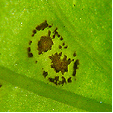 Pustules
Pustules
Symptoms
The upper leaf surface develops red, brown or yellow areas and the underside produces bright yellow to orange spores that correspond to the patches above. Infested leaves become brown in patches, fall prematurely and flower and fruit may also be infected. This overall, results in a loss of vigour and in small plants may lead to death.
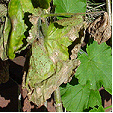 Pelargonium x hortorum
Pelargonium x hortorum
Myrtle Rust (Puccinia psidii) This fungal disease infects plants in the Myrtaceae family and was only recently detected in 2010 and has since spread across eastern Australia from the Northern Territory to Queensland, NSW, Victoria and Tasmania. This rust attacks soft and actively growing foliage or shoots with varying symptoms. It normally starts as small purple spots on the leaves from which spores form in yellow pustules that fade to grey as the infection matures and can merge creating leaf distortion and death of the plant.
The life cycle starts when the powdery yellow spores are distributed by wind to other plants where they germinate and start to grow by piercing the plant cells to obtain nutrients. Germination occurs in dark moist positions with a temperature between 15° to 25°C and the new pustules can release spores in 10 to 12 days, (spores remain viable for 3-months). The spores spread rapidly by wind, water, insects or animals. They are also distributed by plant material, clothing, shoes and vehicles.
 Puccinia psidii
Puccinia psidii
Needle Rust (Melampsora farlowii) infects the new leaves turning them to yellow and fall from the shoot giving the branch a scorched appearance. The fruiting bodies are found on the underside of the leaf and is waxy-red.
Rust in Poplar (Melampsora species). A fungal problem involving at least two species (Melampsora medusae) and (Melampsora larici-idaei).
The upper leaf surface becomes flecked with yellow to light green and the underside produces bright yellow orange spores that correspond to the patches above. Infested leaves become brown in patches, fall prematurely and shoots may die back as a result of not being hardened off to the elements. This overall, results in a loss of vigour and in small plants may lead to death.
The source of the fungus is from other infected plants or fallen leaves and is dispersed by wind.
Host plants include Lombardy Poplars particularly Populus nigra 'Italica' and cottonwoods.
White Rust (Albugo candida) forms snow white pustules that contain colourless spores that turn yellow then brown and are found on the underside of leaves.
White Pine Blister Rust (WPBR) is caused by the fungus (Cronartium ribicola). It is a obligate parasite requiring a living host to survive. The life cycle requires two host species with part of it life on the Pinus species and the other part on Ribes species. First cankers or sores appear on the Pinus species realising spores that land on the Ribes species infecting it. The infection produces a different type of spore that land on the needles and growing branches of the Pinus species and eventually forming cankers. The spores are spread by wind and prefer cool moist conditions. Symptoms include brown spots on the needles and the appearance of dead branches in the crown. Cankers will also appear on the trunk and it tends to attack young trees. Control methods include removal of Ribus species in the affected areas and breading naturally resistant Pinus species.
The Rust (Endophyllum sempervivi) affects Sempervivum species by infecting the young leaves and eventually the crown. The mycelium then travels to the roots and extends into any off shots. Leaves that are infected turn yellowish, grow longer and are thin. Persistent infection may kill the plant.
Source and Dispersal
The source of the fungus is from other infected plants or fallen leaves that contain the fruiting bodies and is dispersed by wind.
Favoured Conditions
Generally rust is more prevalent during summer, preferring warm humid conditions and particularly when the leaves are damp.
Affected Plants
A wide range of ornamental annuals, perennials, ferns, trees, shrubs including, Hibiscus species that are infected by Kuehneola malvicola predominantly in southern USA.
Abies species are infected by many types of rust including (Milesia fructuosa) and (Uredinopsis mirabilis).
Abutilon, Phymosia and Alcea species are infected by the rust (Puccinia heterospora).
Alnus species are occasionally infected with Leaf Rust (Melampsoridium hiratsukanum) which forms yellowish pustules on the leaves that develop turning the leaf brown.
Amelanchler species and Calocedrus decurrens are infected by several rust species including (Gymnosporangium libocedri).
Antirrhinum majus (Snapdragon) is infected by the rust (Puccinia antirrhini). This fungal problem that infects the epidermal layer on the leaf underside, forming pale green areas that are raised and split open revealing reddish brown spores that have a dusty appearance.
As the infestation grows, concentric rings of spore pustules appear around the original infection. The corresponding position on the upper leafs surface turns yellow eventually causing the leaf to wilt and die. The infestation is not restricted to the leaves; all above ground parts of the plant are susceptible and infected plants transmit the fungus dispersing it by wind.
Infected plants should be removed and destroyed.
Anemone and Prunus species are infected by the rust (Tranzschelia pruni-spinosae) that stimulates abnormal growth in the plant during spring.
Aquilegia, Anemone, Delphinium and Clematis species are infected by the Rust (Puccinia rubigo-vera var. agropyri).
Arctostaphylos manzanita is infected by the rust (Pucciniastrum sparsum) occurring in coastal regions but is not normally detrimental to the plant.
Artemisia species are infected by the rust (Uromyces ari-triphylli) which is a systemic disease that is transmitted through seeds. It causes the leaves to turn yellow then die and can infect all parts of the plant except the roots.
Bambusa species are infected by the rust (Dasturella divina) which forms elongated brownish strips on the leaves.
Berberis species may be infected by the Rust (Puccinia graminis) that forms orange spotting on the leaves. It certain regions plants infected with this rust must be removed and destroyed to avoid infecting neighbouring agriculture crops.
Betula species may be infected by Leaf Rust (Melampsoridium betulinum) that forms reddish-yellow spots on the leaves and heavy infestation can defoliate the tree. The host tree changes to Pseudolarix species during the sexual stage and causes blistering of the leaves.
Calendula species may be infected by the Rust (Puccinia flaveriae).
Callistephus and Solidago species may be infected by the Rust (Coleosporium solidaginis) which forms bright yellow spots particularly on new foliage or young plants.
Canna species may be infected by the rust (Puccinia Thaliae).
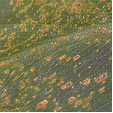
 Canna indica
Canna indica
Centaurea species are infected by the rust (Puccinia cyani) and (Puccinia irrequisita) which can cover the stems and leaves.
Cleome species are infected by the rust (Puccinia aristidae) but rarely requires control.
Dianthus species are infected by the rust (Uromyces dianthi) which forms powdery brown spots that appear on both sides of the leaves. The leaves curl and die and the plant becomes stunted. This is a common problem that occurs when grown in a protected enclosure (hot house).
Ficus species are infected by the rust (Cerotelium fici) which forms small brown spots, and causes the leaves to turn yellow then fall prematurely.
Fuchsia species are infected with (Pucciniastrum epilobii). This fungus caused purplish red blotches on the upper leaf surface, that become dry in the middle and result in a brown patch with purple edges. On the underside of the leaf, corresponding to the patches, yellow orange spores form. Heavily infected leaves become yellow and drop prematurely. This leads to a loss of vigour in the plant and infected plants transmit the fungus.
Certain cultivars are more susceptible than others, particularly 'Orange Drops' and 'Novella'.
Hydrangea species is infected by (Pucciniastrum hydrangeae) causing yellowish brown pustules to appear on both sides of the leaf. The leaf becomes dry and brittle.
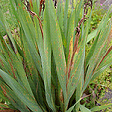
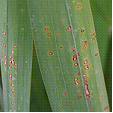 Iris species
Iris species
Iris and Dietes species are very susceptible to the rust (Puccinia iridis). Leaves form rusty red powdery spots that enlarge. They are appear on both sides of the leaves causing the surrounding area to turn pale yellow then brown and the black spores appear soon after, overwintering on dead infected leaves. Plants may be heavily infected but normally survive attack.
Larix species are infected by several Needle Rusts including (Melampsora paradoxa), (Melampsora medusae) and (Melampsoridium betulinum). The fungi attacks the needles predominantly towards the branch tips turning them yellow and eventually killing them . The underside of the leaf develops pale yellow fruiting bodies.
Lupinus species are infected by three species of rust including (Puccinia andropogonis var onobrychidis).
Malus andChaenomeles species may be infected by the rust (Gymnosporangium juniperi-virginianae) or (Gymnosporangium clavipes) which forms brown or bright orange spots on the leaves or twigs and can defoliate the tree. Juniperus virginiana and Mespilus germanica may also be infected by rust.
Mathiola and Arabis species are infected by White Rust.
Pinus species are infects by the Comandra Blister-rust (Cronartium comandre).
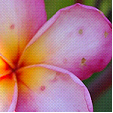
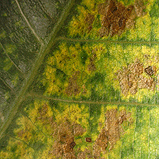
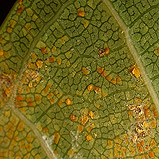
Plumeria rubra Leaf upper surface Leaf underside
Plumeria species are susceptible to the rust (Coleosporium plumeriae). Leaves and flowers may be infected with the underside forming bright yellow pustules and causes premature leaf or flower drop.
Populus nigra 'Italica' is infected by the rust (Melampsora species) which forms pustules to form on the leaves turning them brown and causing premature leaf drop.
Rhododendron and Tsuga species are infected by the rust (Pucciniastrum vaccinii) and is commonly found in nursery stock, spreading rapidly. Tsuga species are also infected by Needle Rust.
Ribes species are infected by the rust (Cronartium ribicola). This leaf rust appears on the underside of the leaves (preferably older leaves) forming dusty brown pustules and is a serious problem. This rust only appears when White Pine (Pinus strobes) grows near where the alternate stage of the fungus occurs.
Rudbeckia species are infected by several species of rust including (Puccinia dioicae) and (Uromyces rudbeckiae).
Salix species are infected by four types of (Melampsora species).
Senecio, Bellis and Calendula species are infected by the rust (Puccinia lagenophora) which forms blister-like pustules that release brown spores.
Sorbus aucuparia is affected by several rust from the (Gymnosporangium species) causing circular yellow spots, that appear on the leaves during summer and develop into orange cup-shaped fruiting bodies.
Trillium species are infected by the rust (Uromyces halstedii) that damages the leaf surface.
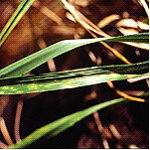 Festuca arundinacea
Festuca arundinacea 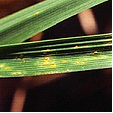 Rust
Rust
Turf Grass are susceptible to rust (Puccinia species) and (Uromyces species), causing yellow flecks to appear on the stems and leaves. These markings enlarge before the pustules form and in severs cases the lawn has a yellow, red or brown appearance.
The infection appears from spring to summer under humid low light conditions and turf that is under stress or with excessive nitrogen in the soil is more susceptible. Many species may be infected including Lolium perenne (Perennial Ryegrass) and Poa pratensis (Kentucky Bluegrass).

 Rust on Perennial Ryegrass
Rust on Perennial Ryegrass
Viburnum species are mildly affected by two types of rust (Coleosporium viburni) and (Puccinia linkii).
Viola species are infected by the rust (Puccinia violae) which forms green spots on the underside of the leaves. It is not commonly seen on cultivated plants.
Non-chemical Control
Cut off and destroy any infected branches, fallen leaves and remove heavily infected plants. Improve the culture by, pruning to improve air circulation, allow space between plants and avoid over crowding. Avoid planting susceptible species. Plants that are infected with a systemic form should be removed and destroyed
Chemical Control
Not possible to spray large trees but young plants may be treated with a protectant fungicide such as wettable sulphur. In a domestic garden small plants such as Fuchsia species may be sprayed with a protectant chemicals as symptoms appear, aided by the removal of existing infected leaves. Under commercial conditions stock may be sprayed with a fungicide such as oxycarboxin.
Note
Always read the label for registration details and direction of use prior to application of any chemicals.
Average Lowest Temperature : -1º C 30º F
USDA : 9, 10, 11
This USDA (United States Department of Agriculture) hardiness zone chart can be used to indicate a plant’s ability to withstand average minimum temperatures. However, other factors such as soil type, pH, and moisture, drainage, humidity and exposure to sun and wind will also have a direct effect on your plant’s survival. Use this chart only as a guide, always keep the other factors in mind when deciding where, when and what to plant.
A plant's individual USDA zone can be found in the Plant Overview.
Region of origin
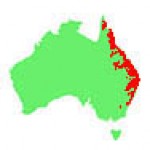
Australia, (northern New South Wales to northern Queensland)
Climate Description
Warm to Sub-tropical
This overlaping zone has ample rain with high summer temeperatures and high humidity. Winters are mild. Pockets of sub-tropical climates exist within coastal warm temperate zones.
Frosts and droughts rarely occur along the coast.
Plant growth
Tropical and warm temperate native and exotic plants grow well.
| Dictionary | Growth Habit |
| Leaf Type | Botanic Flower Description |
| Leaf Shape | Flower Inflorescence |
| Leaf Arrangement | Fruit Type |
| Leaf Margin | Bark Type |
| Leaf Apex And Bases | Flower Description |